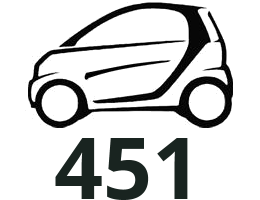Mod Details
PremiumNo Difficulty



 Mod ID1401
Creditevilution
For
Mod ID1401
Creditevilution
For Linkhttps://www.evilution.co.uk/mod/451-dpf-regeneration.htm Copy to Clipboard
Linkhttps://www.evilution.co.uk/mod/451-dpf-regeneration.htm Copy to ClipboardWhat Is A DPF?
It’s a diesel particulate filter, it’s inside the exhaust. It catches all of the particles of soot from the engine. This improves the quality of the emissions from the exhaust.
Do I Have A DPF
The smart fortwo 451 diesel manufactured after October 2009 has a DPF. No other smart models have a DPF.
What Is DPF Regeneration?
ECU increases fuelling to increase the temperature of the DPF to 580˚C. The soot in the DPF is burnt and pushed through the DPF and out into the atmosphere.
Does The DPF Reduce Emissions?
Yes. When the trapped soot is heated to nearly 600˚C it passes its autoignition temperature, at which point it completely combusts in the presence of oxygen.
What Does The DPF Do?
It collects the soot until the ECU decides that the DPF is full. The fuel timing is then changed so extra fuel is injected into the cylinder after the combustion cycle. The unburnt fuel leaves the engine but ignites in the exhaust due to the oxygen still present after the combustion cycle in a diesel engine. The burning of the fuel bourne catalyst and the oxygen drastically increases the temperature of the exhaust gasses.
This increases the over-all temperature of the DPF to nearly 600˚C which is hot enough to cause the captured soot to completely burn up on contact with the remaining oxygen still present from the combustion cycle.
The emissions consist mainly of nitrogen. The remaining emissions being a near equal split of oxygen, carbon dioxide and water vapour. A very small percentage of the emissions are classed at pollutants.
These pollutants are:
Unburned Hydrocarbons.
Carbon Monoxide.
Nitrogen Oxide.
Particulate Matter.
Metallic Particles (from the DPF).
Low Emissions. Perfect right?
Yes and no. It’s great that the emissions are reduced but a study suggests that during regeneration, in real world use, there is an increase in 5nm and 10nm (nanometer) particles.
Normal particulate matter (soot) is classed as:
PM10 – Equal or greater than 10µm
PM2.5 – Equal or greater that 2.5µm
10µm = 10000nm
So you can see that 5nm and 10nm particles (nanoparticles) are orders of magnitude smaller. These smaller particles can travel further and get deeper into your lungs. So, in real world use, there are pros and cons. Lower emissions but possibly more dangerous to health.
Emissions Check When The DPF Is Regenerating?
The MOT emissions test cannot test for particulates that small so it’ll pass.
There are 3 possibilities. Either:
The overfuelling at 1100rpm is enough to very slowly regenerate the DPF.
The overfuelling at 1100rpm is enough to stop any new build up in the DPF.
The 1100rpm is just a sign that the car is attempting to regen and it’ll give up trying to regen if you don’t drive it (and it’ll try again the next time you drive).
What Are The Regeneration Parameters?
The car will not attempt to regenerate the DPF unless:
The car is up to operating temperature.
The exhaust dual pressure sensor measures a restriction in the DPF.
The RPM is about 2200 (approximately).
The car will not regenerate if:
The exhaust pressure sensor is faulty.
The turbo temperature sensor is faulty.
The DPF temperature sensor is faulty.
If any of the sensors are faulty, the car will generally go into safe (restricted power) mode. This is to warn you of the problem and to reduce the amount of soot being pushed into the DPF.
So, Soot Blocks The DPF?
Not usually, no. If the DPF is blocked by soot, you have other issues with the engine like a blocked EGR valve or faulty sensors. Generally, what blocks the DPF is ash. When the soot is burnt, most of it turns into particulates but you will also get a tint amount of ash. This ash cannot be burnt and slowly clogs the DPF.
What If My DPF Is Blocked?
There are companies that back-wash the DPF exhaust to force the build up out. They use pulsed high pressure water to shift blockages.
I have heard of people using Coca-Cola. Take the exhaust off the car, remove the sensors. Block off the engine end of the exhaust, pour coke into the outlet end and let it sit.
The mild acid should break down the ash. Remove the block and drain it from the engine end. Will this work, I really don’t know. I’ll try it one day. I’d be concerned about the sugar and caramel colours causing further issues later on. Maybe a suger free clear acidic drink would be better. Or vinegar.
I’m sure you can buy proper cleaning fluids that you can use instead. Water may work a bit but it’s not going to be affective at normal pressures. Nothing that you can add to the engine will unblock a DPF properly. It’s blocked.
This guy has made a good video which tests some cleaning fluid. He does go on a bit too long though.
Basically, he runs a strong alkali (sodium hydroxide) through it to clear the oily soot and ash out. He then runs a acid/water mix through the DPF to clear out the dried ash. After allowing it to soak, the DPF is flushed through with copious amounts of water to neutralise the acid.
Removing The DPF
Unfortunately it’s not something you can get away with now since they updated the MOT.
Credits
Thanks to Paul T for nudge so I actually did some research on the subject instead of write about things I half remembered reading years ago.


